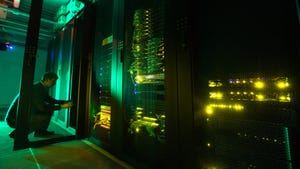Dept. of Energy Challenges Agencies to Improve Data Center Efficiency
The Data Center Energy Challenge calls upon federal agencies to improve energy efficiency of their data centers by 20 percent by 2020, and private-sector data center operators are welcome to join.
May 30, 2014

Continuing the pursuit of more energy efficient data centers, the U.S. government is preparing to issue a “challenge” to its agencies, as well as interested companies in the private sector, to improve energy efficiency of their data centers by 20 percent by the year 2020.
The Data Center Energy Challenge is a spin on similar programs the government has conducted before for other types of buildings, William Tschudi, program director at the Department of Energy’s Lawrence Berkeley National Laboratory in Berkeley, California, said.
“There was a Better Buildings Challenge, directed at commercial buildings, and it was successful,” he said. “This is a challenge specifically for data centers.”
The U.S. federal government as a whole is arguably the world’s largest data center user. While nobody knows the exact amount of all data centers agencies use, a 2011 government-wide inventory pegged it at more than 3,100.
In parallel to a four-year-old data center consolidation initiative, there has been a push in the government to optimize energy efficiency of the facilities that are spared from closure or facilities whose fate remains undetermined.
LBNL to act as the program’s brain center
The Data Center Energy Challenge is being organized by the Government Information Technology Executive Council and LBNL. The national lab will house a Center of Expertise for the program, offering guidance to agencies, setting up a protocol to track progress, analyze the progress and make recommendations for improvements.
“The DoE has reached out to a few federal and private data center operators and there’s half a dozen to a dozen already signed up,” Tschudi said.
While this is a federal energy program, the DoE encourages private-sector data center operators to participate as well. The department is trying to get some tech giants, such as Facebook, to sign up.
LBNL’s Center of Expertise will also work with private-sector companies to help them provide tools participants in the challenge can use to meet their efficiency goals. It is also working with industry organizations, such as The Green Grid, to establish a better information pool.
Attempts to legislate efficiency unsuccessful
In addition to coming during a government-wide data center consolidation project, the challenge, currently in its early stages, is being developed as Congress considers legislation that would mandate federal data center energy efficiency.
The House passed one of the bills, called Energy Efficiency Improvement Act of 2014, in March. It calls on regulatory agencies to create and enforce energy efficiency standards for agency data centers. Data center infrastructure equipment vendor Schneider Electric, The Greed Grid and the IT Industry Council all supported it.
A sister bill, the much debated Energy Savings and Industrial Competitiveness Act of 2014, also known as the Shaheen-Portman Bill, was killed, blocked before the Senate had a chance to vote on it.
Jay Owen, vice president of IT Federal Solutions at Schneider, said none of the legislation would pass, however. “If these bills were passed, it would have accelerated initiatives.”
Systemic roadblocks to better IT
There are several factors preventing the government from hitting its lofty efficiency goals. “The culture of the way they’ve been built hasn’t been conducive,” Owen said. “There are departments, sub-departments, and you’re telling them they have to go and move into other facilities. There’s not a clear reporting hierarchy.”
There are also budgeting issues. Budgets are passed and approved for short periods of time, making long-term projects, such as the consolidation and energy efficiency improvements, difficult to take from start to finish.
One solution to the budgeting issue is an Energy Savings Performance Contract. This is where a vendor implements an efficiency solution and gets paid out of cost savings that result from the smaller electricity bill of the customer agency.
About the Author
You May Also Like

.jpg?width=300&auto=webp&quality=80&disable=upscale)





